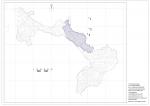Summary (English)
In 2013, excavations were undertaken in the area in front of the ancient cavern entrance to investigate the nature of the phases preceding the collapse that occupies it. This raised a series of questions on the dynamics of the latter’s formation and on the development of the subterranean complex itself.
The 2014 campaign was substantially conditioned by the fact that it was underway when the Gargano peninsula was hit by a flood. The work was thus limited to undertaking a detailed survey of the upper chamber, which shows a morphology that is more elongated towards the Occhiopinto cave. This suggests the existence between the two caverns of a wide and easy access later blocked by collapsed boulders (fig. 1). Contrary to what has been previously suggested, the concentration of ritual deposits was not limited to the lower north-eastern gallery, given that similar deposits were identified in the narrow unexplored passages in the opposite south-eastern direction.
Three core samples were taken using a hydraulic core sampler, which obtained undisturbed samples of the substrata.
Of the samples, numbers 1 and 2 showed no break in the rocky substrata. In these two zones there did not appear to be any subterranean cavities, at least as far as the levels reached. On the contrary, sample 3 was taken close to the edge of the known chambers by the Scaloria cavern. The result of one limited empty space confirmed the suggestion that the profile of the vault was thicker in this zone (8 m rather than 2-2.5 m at the entrance) at the edges of the known karstic complex in areas that are difficult to reach from the interior. These chambers could perhaps be seen on the geo-electric profiles made of the external field using a very close grid, as chambers and/or cuniculi linking the larger spaces that are beginning to appear following the emergence of the anomalies.Genoa-DISTAV and Tubingen Universities than undertook a new geo-electric survey of 15 parallel transects using a very dense grid (see following image) that produced a 3D model of the underground structures in order to further clarify the characteristics of the karstic complex.
The preliminary geomorphological analyses of the territory surrounding the complex and in particular of the canyons (Scaloria-Pulsano) that cut into the alluvial fans of the Gargano foothills and the terrace on which the Scaloria cave opens, highlighted the substantial nature of the alluvial deposits. The summit portions of these deposits probably of Würmian (glacial) date are constituted by very large clasts and characterised by concentrated flow structures denoting the high energy and capacity of the torrent. The deep incision revealed the lower and earliest part of the fan, characterised by limestone breccias attributable to the Pleistocene era.
In the distal part of the fan, to the rear of the Scaloria cave, the deposits became shallower and were constituted by smaller clasts often alternating with silty-sand layers, which directly overlay the limestone substratum. The upper layers showed clear signs of pedogenesis and presented horizons of carbonate (calcite) accumulations in the form of crusts and nodules, attesting the calcification processes associated with very arid climates.
- Eugenia Isetti- Istituto Italiano per l’Archeologia Sperimentale-Genova
- Antonella Traverso- Soprintendenza per i Beni Archeologici della Liguria
Director
Team
- Guido Rossi- Museo di Archeologia Ligure Genova
- Ivano Rellini – DISTAV Università degli Studi di Genova
- Karin Bihler – Unifi- Università di Tubinga
- Luigi Mucerino – DISTAV Università degli Studi di Genova
- Marco Firpo - DISTAV Università degli Studi di Genova
- Mikael Marker - Univesità di Tubinga
Research Body
- Istituto Italiano per l’Archeologia Sperimentale-Genova






![Download [PDF]](/excavation/skins/fasti/images/results/download_sml.png)